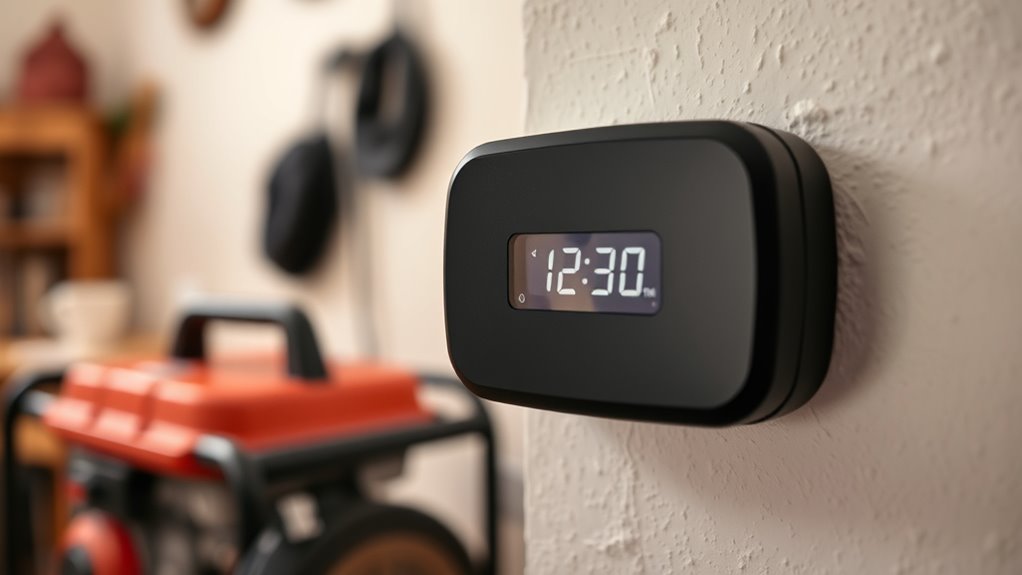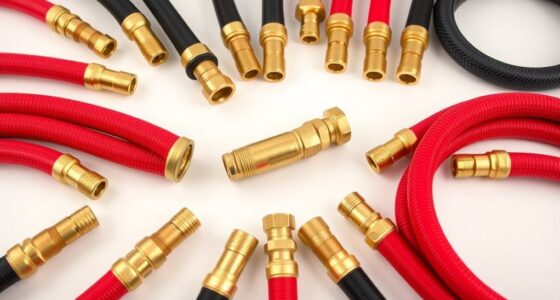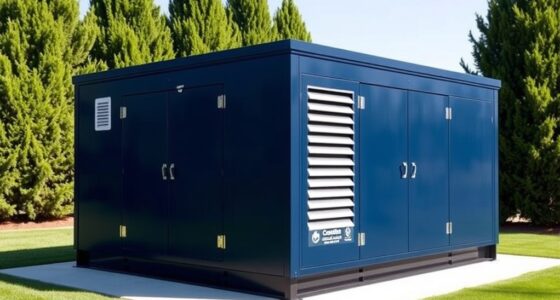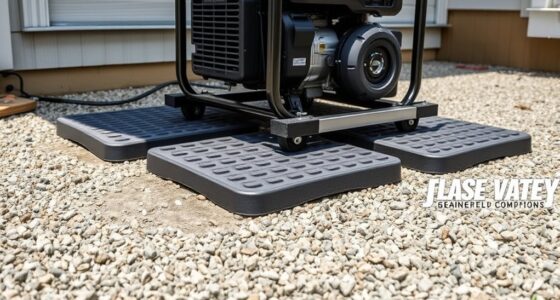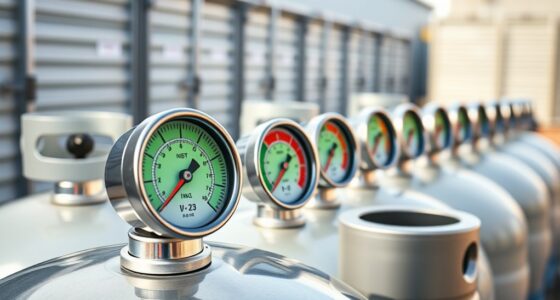If you’re looking to stay safe during power outages, I recommend checking out the top CO alarms designed for generator use. These include battery-powered detectors like Kidde, models with backup batteries like First Alert CO400, plug-in options such as First Alert CO605, and multi-threat detectors with LCD displays and additional sensors. Some are OEM modules for inverter generators, ensuring automatic safety shutdowns. Keep in mind features like sensor accuracy, loud alarms, and easy maintenance. Keep going, and you’ll find the best choices for your safety needs.
Key Takeaways
- Different types of CO alarms, including battery-powered, plug-in, and OEM modules, suit various generator safety needs.
- Features like fast response sensors, loud alarms (85+ dB), and digital displays enhance detection and alert effectiveness.
- Compatibility with generator power sources and easy installation are crucial for reliable operation during outages.
- Long-lasting sensors, regular maintenance, and low battery indicators ensure continuous, dependable CO detection.
- Certified models with safety standards like UL listing and automatic shutoff modules improve overall generator safety during power failures.
Kidde Battery-Powered Carbon Monoxide Detector
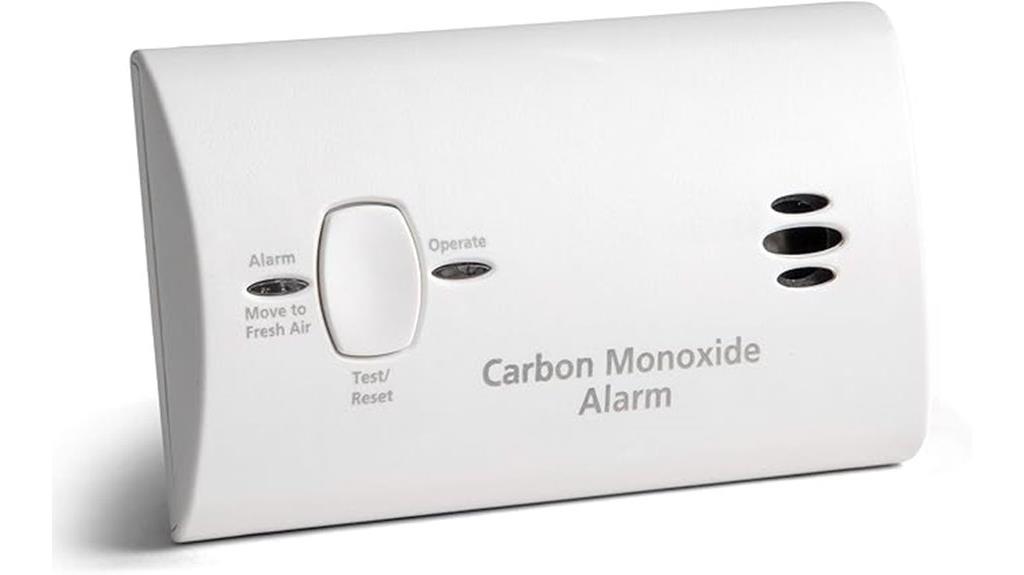
If you’re looking for a reliable CO alarm that’s easy to install and perfect for backup power situations, the Kidde Battery-Powered Carbon Monoxide Detector is a top choice. It runs on 2-AA batteries, so no wiring is needed, and it keeps you protected during power outages. Its electrochemical sensor accurately detects CO, triggering an loud 85-decibel alarm and flashing LEDs. The unit is portable, suitable for wall or tabletop placement, and features a test-hush button for quick functionality checks. With a simple slide-out battery door and low battery indicator, it’s designed for easy maintenance and reliable safety in all living areas.
Best For: homeowners and travelers seeking a reliable, easy-to-install CO detector that operates during power outages and requires minimal maintenance.
Pros:
- Battery-powered with no wiring needed, suitable for easy installation anywhere in the home or on-the-go.
- Electrochemical sensor technology ensures accurate detection of carbon monoxide levels.
- Loud 85-decibel alarm and LED indicators provide clear, immediate alerts for safety.
Cons:
- Uses 2-AA batteries, which require regular replacement to ensure continuous protection.
- Limited lifespan of approximately 7 years before replacement is recommended.
- May not have advanced smart features or connectivity options found in some newer models.
First Alert CO400 Carbon Monoxide Detector, Battery Operated Alarm
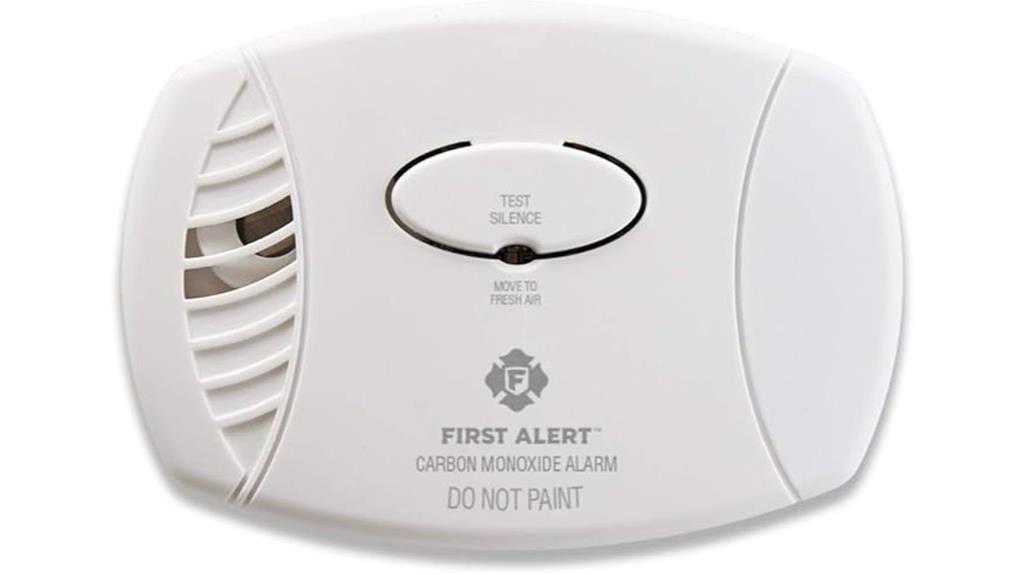
The First Alert CO400 Carbon Monoxide Detector stands out as an ideal choice for homeowners seeking reliable, battery-powered CO detection without the need for electrical outlets. It uses a highly accurate electrochemical sensor with a lifespan of up to five years, providing long-term protection. Powered by a 9V replaceable battery, it remains operational during power outages. When dangerous CO levels are detected, it emits an loud 85-decibel alarm, ensuring immediate awareness. Its attractive, versatile design allows placement anywhere, and visual plus audible signals alert you to low battery or end-of-life status. UL-listed and easy to install, it’s a dependable safeguard for your home’s safety.
Best For: homeowners seeking a reliable, easy-to-install battery-powered carbon monoxide detector that provides long-term safety without the need for electrical outlets.
Pros:
- Uses an advanced electrochemical sensor with a 5-year lifespan for long-term accuracy and minimal maintenance
- Battery operated with visual and audible signals for low battery and end-of-life alerts, ensuring continuous protection during power outages
- Easy to install, portable, and discreet, suitable for placement anywhere in the home or travel
Cons:
- May not detect low-level or intermittent CO leaks, especially in vehicles or areas with fluctuating CO levels
- Response time can vary depending on CO concentration, potentially delaying alerts for lower or sporadic levels
- Some users report issues with battery contact design, which might affect durability and safety over time
JJing Carbon Monoxide Alarm CO Module CO Sensor
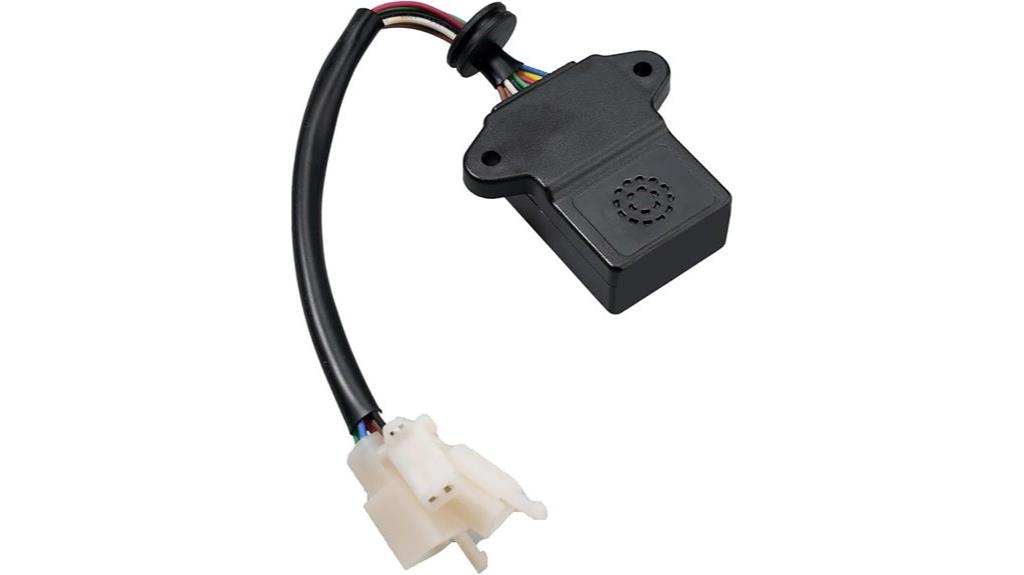
For Predator 5000 inverter generator owners seeking a seamless and reliable carbon monoxide detection solution, the JJing Carbon Monoxide Alarm CO Module stands out as an ideal choice. It’s designed specifically for this model, providing an exact replacement for the OEM CO sensor. This module detects dangerous CO levels and automatically shuts down the generator to keep you safe. It doesn’t emit any alarm sound itself but offers peace of mind through its safety shutdown feature. With positive reviews and easy installation, it’s a trusted upgrade for Predator 5000 owners. Just verify your generator is compatible before purchasing, as it’s not suitable for other Predator models.
Best For: Predator 5000 inverter generator owners seeking a reliable, OEM-compatible carbon monoxide detection upgrade.
Pros:
- Specifically designed as an exact replacement for Predator 5000 CO sensors, ensuring perfect compatibility.
- Provides automatic safety shutdown to prevent CO poisoning without emitting loud alarms.
- Easy to install with positive customer reviews highlighting seamless performance and reliability.
Cons:
- Not compatible with other Predator generator models; verification needed before purchase.
- No alarm sound feature, which may be a drawback for users expecting audible alerts.
- Price and availability may vary; must check online or offline retailers for current pricing.
First Alert Carbon Monoxide Detector with Battery Backup
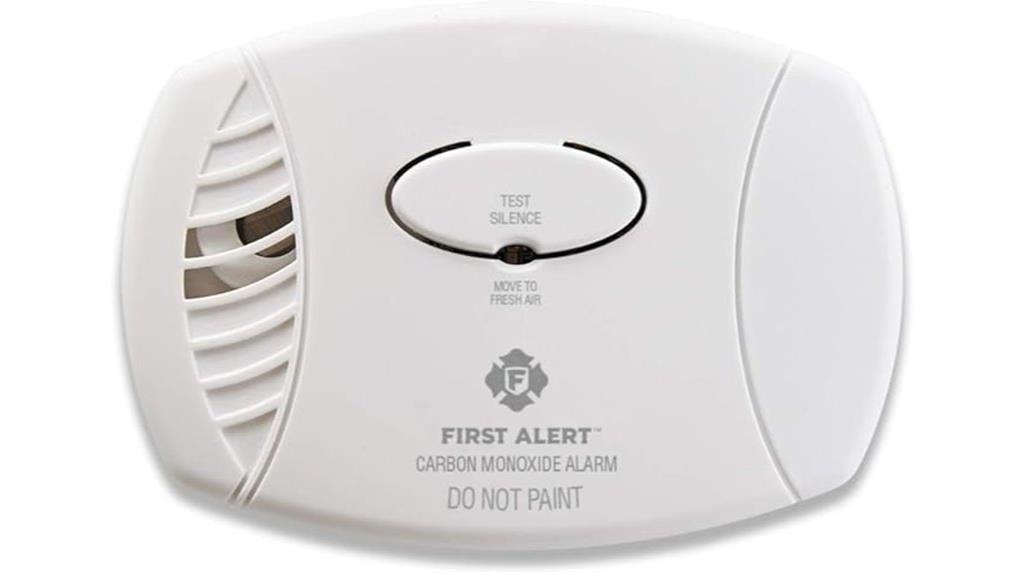
Looking for a reliable CO alarm that you can easily plug into any outlet? The First Alert CO605 is an excellent choice. It features a plug-in design with a battery backup, ensuring continuous protection even during power outages. Its advanced electrochemical sensor provides accurate CO detection, while the loud 85-decibel alarm quickly alerts you to dangerous levels. The device is UL certified and includes a test/silence button, an end-of-life indicator, and a mute function for nuisance alarms. Compact and straightforward to install, it offers peace of mind and reliable safety, making it ideal for any home during a power outage.
Best For: homeowners seeking an easy-to-install, reliable carbon monoxide detector with backup power during outages.
Pros:
- Easy plug-in installation with battery backup for continuous protection
- Accurate detection with advanced electrochemical sensor and loud 85-decibel alarm
- UL certified with a clear end-of-life indicator and mute function for nuisance alarms
Cons:
- Requires regular testing and battery replacement for optimal performance
- May chirp every 30 seconds if the battery isn’t properly inserted or replaced
- Limited to plug-in design, which might not suit all outlet configurations or preferences
2 Packs Carbon Monoxide Detectors
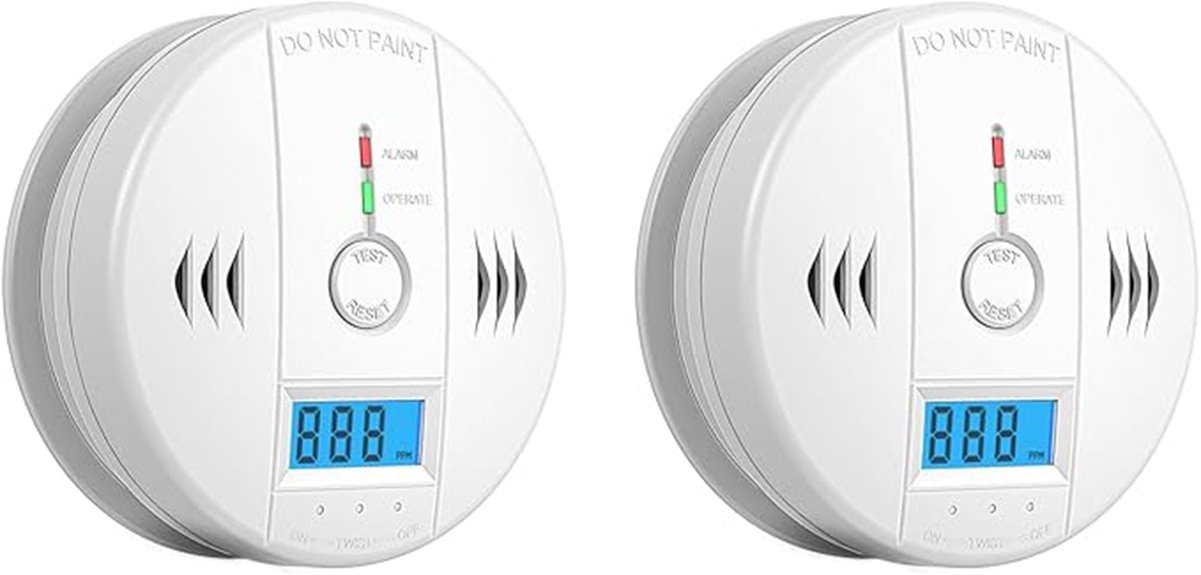
Packs carbon monoxide detectors are an excellent choice for homeowners seeking reliable, easy-to-install safety devices. These units feature advanced electrochemical sensors that detect CO accurately and quickly, alerting you at dangerous levels. The LCD display provides real-time CO monitoring, so you always know what’s happening. Battery-powered and wire-free, they’re simple to mount on walls or ceilings with included hardware. User-friendly controls, like large test and silence buttons, make maintenance straightforward. With features like end-of-life indicators, loud alarms, and long-lasting batteries, these detectors offer all-encompassing protection, making them a smart investment for safeguarding your home.
Best For: homeowners seeking reliable, easy-to-install CO safety devices to protect their entire household from carbon monoxide risks.
Pros:
- Advanced electrochemical sensors ensure high accuracy and quick alert response.
- LCD display provides real-time monitoring of CO levels for continuous safety awareness.
- Battery-powered and wire-free installation simplifies setup without the need for wiring or professional help.
Cons:
- Batteries are not included and need to be purchased separately, which could inconvenience some users.
- Build quality may vary slightly, with some customers noting minor durability concerns.
- Alarms can be loud, which might be disruptive in certain environments or during nighttime.
First Alert Gas and Carbon Monoxide Alarm with Digital Display
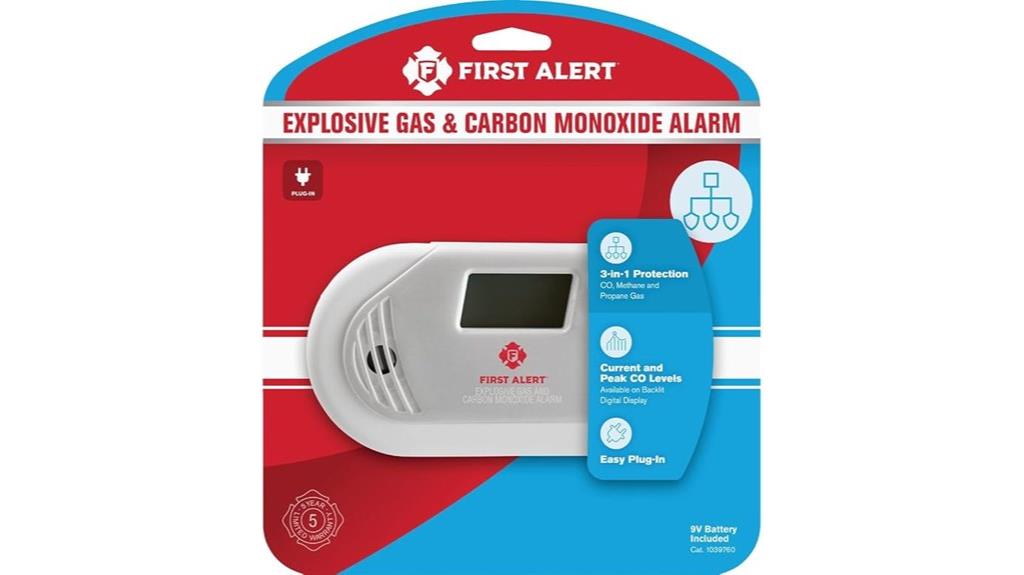
The First Alert Gas and Carbon Monoxide Alarm with Digital Display stands out as an excellent choice for homeowners who want a reliable, all-in-one safety device. It detects natural gas, methane, propane, and CO with electrochemical sensors for accurate readings. The unit plugs into any AC outlet and includes a backup 9V battery for power outages. Its large backlit display shows current and peak hazard levels, while the loud 85-decibel alarm alerts everyone immediately. Easy to install and operate, it also features remote silencing and a test button. This device guarantees continuous monitoring and quick detection, making it a trusted safety tool for protecting your family from gas leaks and CO poisoning.
Best For: homeowners seeking a reliable, easy-to-use all-in-one gas and CO detector for comprehensive safety coverage.
Pros:
- Combines detection of natural gas, methane, propane, and carbon monoxide in one device for convenience.
- Features a large backlit digital display and an audible 85-decibel alarm for clear and immediate hazard alerts.
- Easy to install with plug-in design, backup battery, and remote silencing capability for user convenience.
Cons:
- Some users report false alarms or sensitivity issues if not properly placed or maintained.
- Battery life and sensor expiration should be checked regularly to ensure continued accuracy.
- May require multiple units in larger homes for full coverage, increasing overall cost and maintenance.
Carbon Monoxide Detector with Digital LCD Display and Battery Power
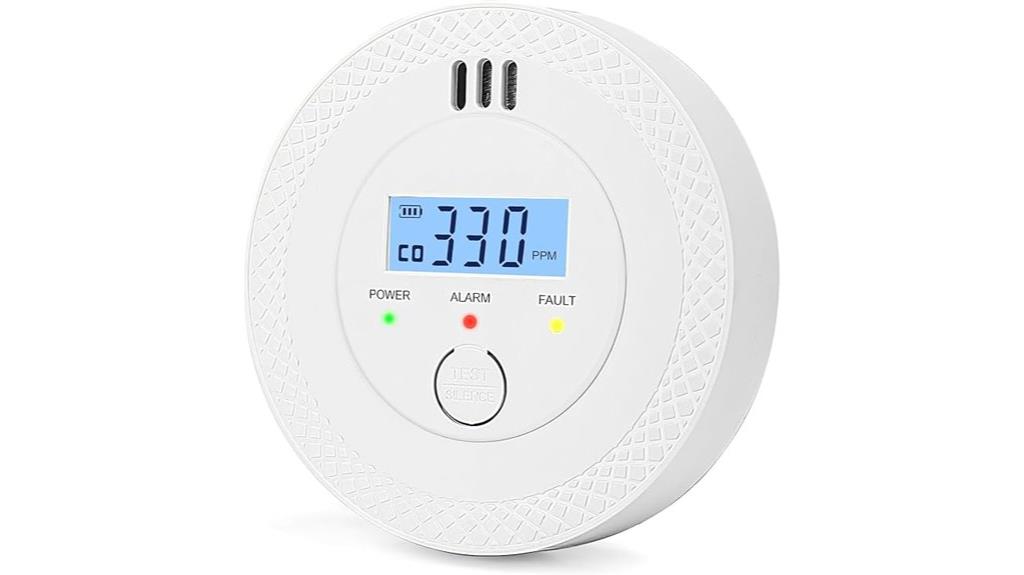
If you want a reliable CO alarm that’s easy to install and maintain, the Carbon Monoxide Detector with Digital LCD Display and Battery Power is an excellent choice. Its compact size and high-performance electrochemical sensor guarantee sensitive, instant detection of CO levels. Powered by two included AA batteries, it offers continuous protection even during power outages. The LCD shows real-time CO concentration and power status, while the three LED indicators alert you to alarms and faults. Waterproof and dustproof housing makes it suitable for humid areas like kitchens and garages. Overall, it’s a dependable, user-friendly device that keeps your family safe without hassle.
Best For: homeowners and travelers seeking an easy-to-install, reliable CO detector with real-time monitoring and alerts.
Pros:
- Compact, MINI size with straightforward wall or ceiling mounting.
- Highly sensitive electrochemical sensor provides instant CO detection.
- Waterproof and dustproof housing ensures durability in humid environments.
Cons:
- Requires two AA batteries, which need replacement over time.
- LCD display brightness dims when not actively updating, possibly reducing visibility.
- Limited to battery operation without a built-in power cord or backup connection.
Carbon Monoxide Detectors Plug-in, 10-Year Battery Operated Co Monitor Alarm
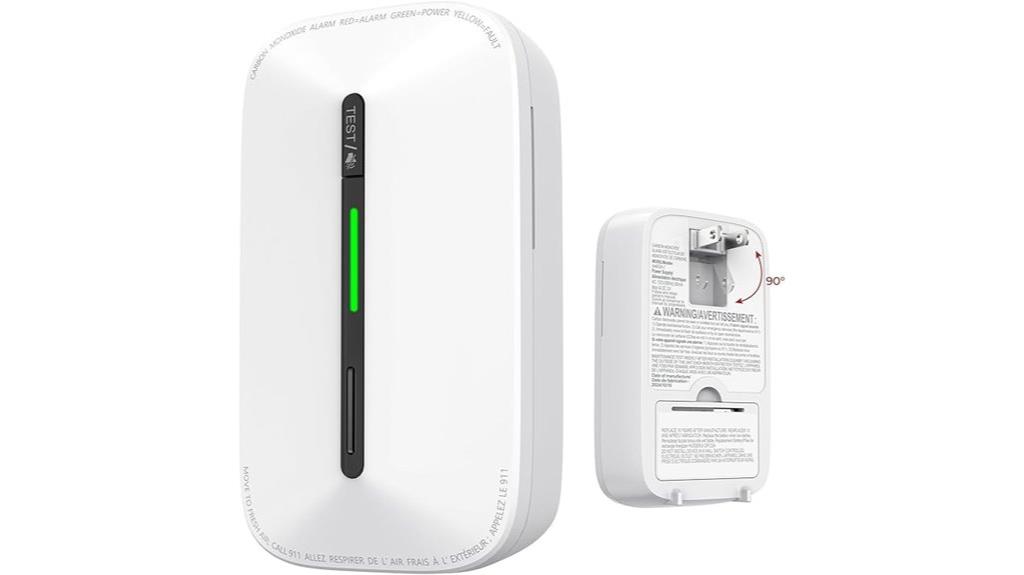
For anyone seeking a reliable, maintenance-free carbon monoxide alarm, the Plug-in CO Detector with a 10-year battery backup stands out as an excellent choice. It features an AC plug-in design with a built-in rechargeable battery that keeps it running during power outages. Its compact, lightweight size makes it perfect for travel, RVs, or hotel stays. Equipped with electrochemical sensors, it detects CO accurately while minimizing false alarms. The green status light confirms power, and the breathing-style indicator promotes sleep-friendly operation. Easy to install and test, this device offers continuous protection with no hassle, giving me peace of mind during blackouts and everyday use.
Best For: individuals seeking a reliable, maintenance-free carbon monoxide detector suitable for home, travel, or RV use who want continuous protection during power outages.
Pros:
- AC plug-in design with a 10-year rechargeable battery backup ensures continuous operation during outages.
- Compact, lightweight, and travel-friendly, ideal for hotels, RVs, and luggage.
- Equipped with electrochemical sensors for accurate CO detection and minimal false alarms.
Cons:
- Requires a standard 120V outlet, which may limit placement options in certain areas.
- Basic indicators and prompts may not appeal to users seeking advanced features or digital displays.
- Only includes one C battery, so replacement or additional batteries are necessary after 10 years.
Carbon Monoxide Detector with LCD Display and Alarm
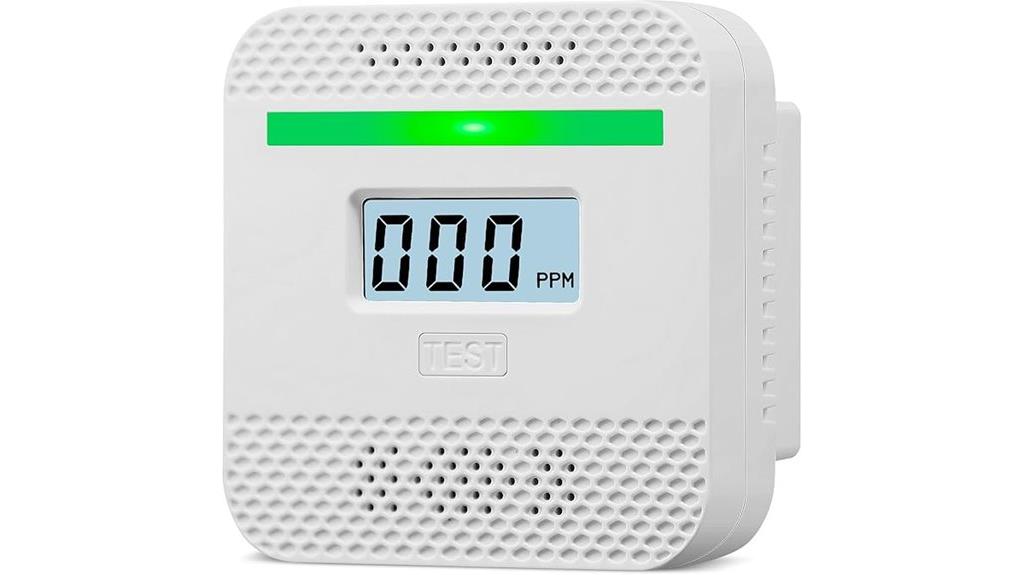
A Carbon Monoxide Detector with LCD display and alarm stands out as an ideal choice for anyone who needs quick, clear readings of CO levels in various environments. Its portable, battery-powered design makes it perfect for travel, home, or office use. The LCD screen provides real-time CO concentration readings, so you always know what’s in the air. When CO levels exceed 100 ppm, an loud 85dB alarm and flashing red lights activate instantly. Easy to test and silence, it’s user-friendly for all ages. With UL certification and high-precision sensors, this detector offers reliable, immediate protection during power outages or everyday safety.
Best For: individuals seeking a portable, easy-to-read carbon monoxide detector for home, travel, or office environments.
Pros:
- Clear real-time LCD display for easy monitoring of CO levels.
- Portable and lightweight, ideal for travel, RVs, or multiple rooms.
- Quick response with loud alarm and flashing lights when CO exceeds safe levels.
Cons:
- Batteries are not included, requiring additional purchase.
- No wired installation needed, but may need frequent battery replacements.
- Limited to battery power, which could affect long-term use without replacement.
RVLP-2B Propane Gas Alarm – 2-Wire, Black
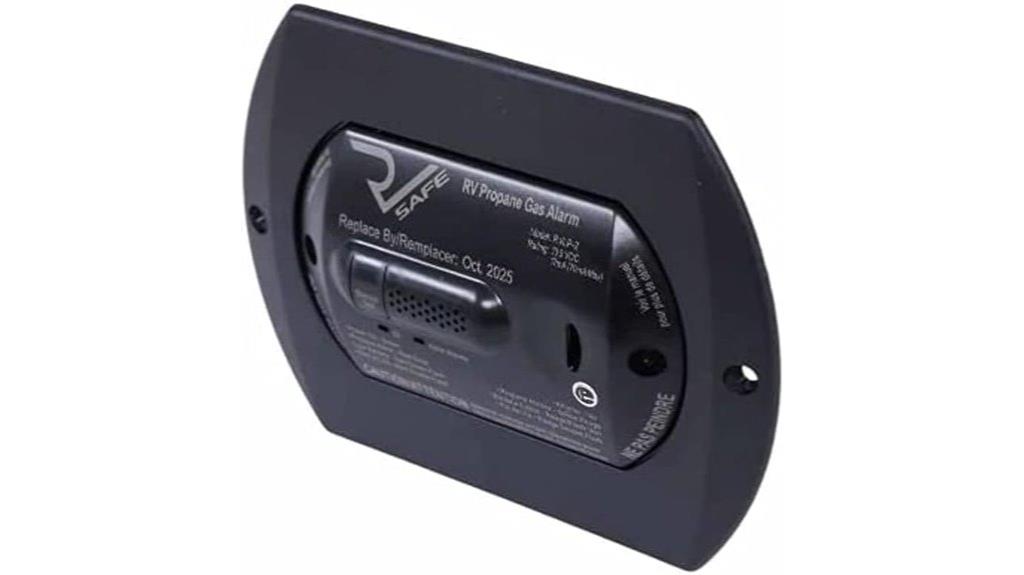
The RVLP-2B Propane Gas Alarm stands out as an ideal choice for RV owners seeking a reliable, easy-to-install safety device. Its compact design and simple 3/4-inch mounting hole make installation straightforward, even for beginners. Equipped with advanced electrochemical sensors, it quickly detects propane and CO gases, providing clear, audible alerts—priority is given to propane if both gases are present. Certified to UL standards, it guarantees dependable performance for up to five years. Many users praise its durability, ease of use, and effective alerts, making it a dependable safety addition for any RV during power outages or when traveling.
Best For: RV owners seeking a reliable, easy-to-install propane and CO safety alarm to ensure peace of mind during travel or power outages.
Pros:
- Easy to install with just a 3/4-inch mounting hole and included brackets
- Advanced electrochemical sensors for quick, accurate detection with minimal false alarms
- UL-certified to meet safety standards with a long five-year lifespan
Cons:
- Requires battery replacement after five years, which may involve some maintenance
- Limited to RV use; not designed for residential or industrial environments
- The alarm’s size may be larger than some users prefer for very tight spaces
Reliance Controls Corporation THP108 PowerBACK! Mains Return Alarm
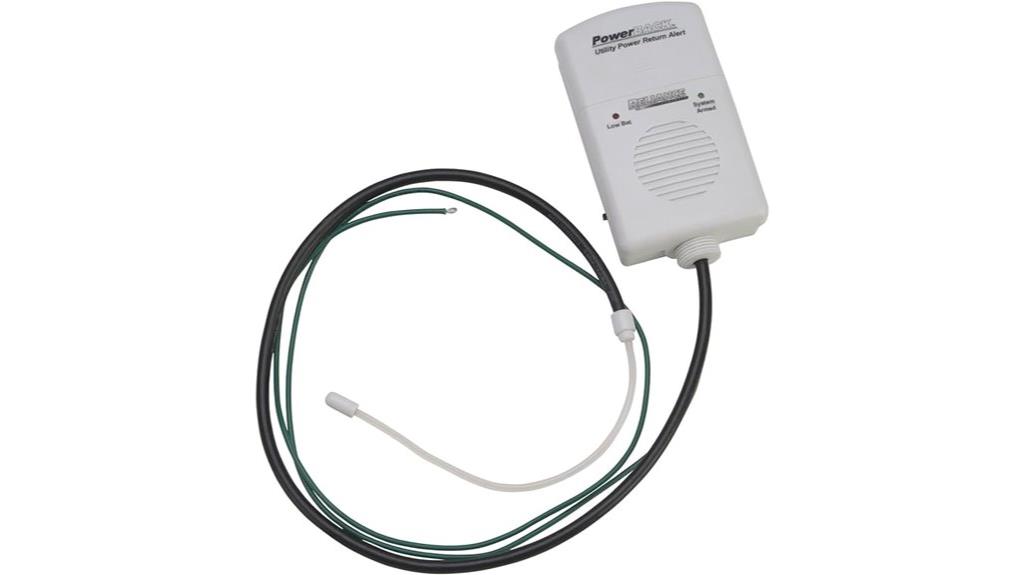
Reliance Controls Corporation THP108 PowerBACK! Mains Return Alarm is a dependable device that works with new or existing breaker panels and transfer switches. I appreciate its easy installation on manual transfer panels or generator-ready load centers. During a power outage, it emits a clear 86dBA alarm at 30cm, alerting me instantly. It also indicates when utility power returns, which is vital for safety. Powered by batteries, it features a low battery indicator, ensuring I stay informed. Overall, it’s a simple, effective solution for monitoring power status and keeping my household safe during outages.
Best For: homeowners and facility managers seeking a reliable, easy-to-install alarm to monitor power outages and restorations in existing or new electrical setups.
Pros:
- Easy to install on manual transfer panels or load centers without extensive wiring
- Audible alert is loud enough (86dBA at 30cm) to be heard clearly during outages
- Battery-powered with low battery indicator ensures continuous operation and maintenance awareness
Cons:
- May require battery replacement over time to maintain functionality
- Does not provide remote or visual alerts beyond the audible alarm
- Suitable primarily for residential or small commercial use; may not be ideal for large-scale or complex electrical systems
Kidde Carbon Monoxide Detector with Battery Power
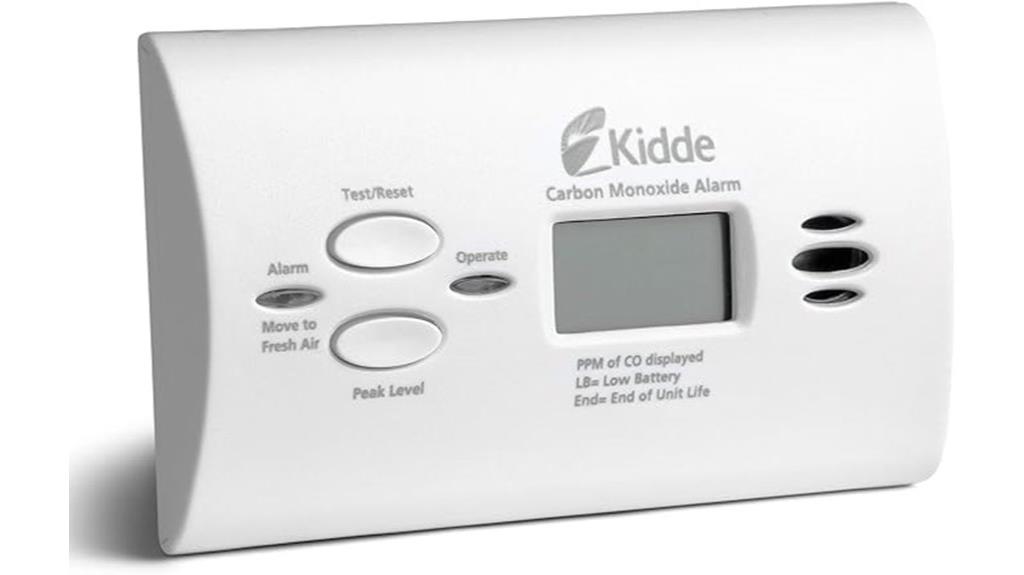
For anyone needing a portable and reliable CO alarm during power outages or while on the go, Kidde’s Battery-Powered Carbon Monoxide Detectors stand out as an excellent choice. These models run on AA batteries, making installation simple without wiring and ensuring they work even if the power goes out. They feature loud alarms at 85 decibels, LED indicators for CO presence and power status, and a digital display on the KN-COPP-LPM to show real-time CO levels. With a long-lasting 10-year warranty for the 900-0146 and a 5-year warranty for the KN-COPP-LPM, they’re built for durability and peace of mind.
Best For: individuals seeking a portable, reliable CO detector that operates during power outages and is easy to install in homes, RVs, or on the go.
Pros:
- Battery-powered with no wiring needed, allowing flexible placement and easy installation
- Loud 85-decibel alarm with clear LED indicators and digital display for real-time CO levels (KN-COPP-LPM)
- Long-lasting with up to 10 years of operation and durable UL certification for safety assurance
Cons:
- Limited to AA batteries, which require periodic replacement to maintain functionality
- Digital display on the KN-COPP-LPM may be more complex for some users to interpret initially
- Higher initial cost compared to basic CO detectors without digital features
Combustible Gas & CO Detector 4-in-1 Alarm with Temp/Humidity Sensor
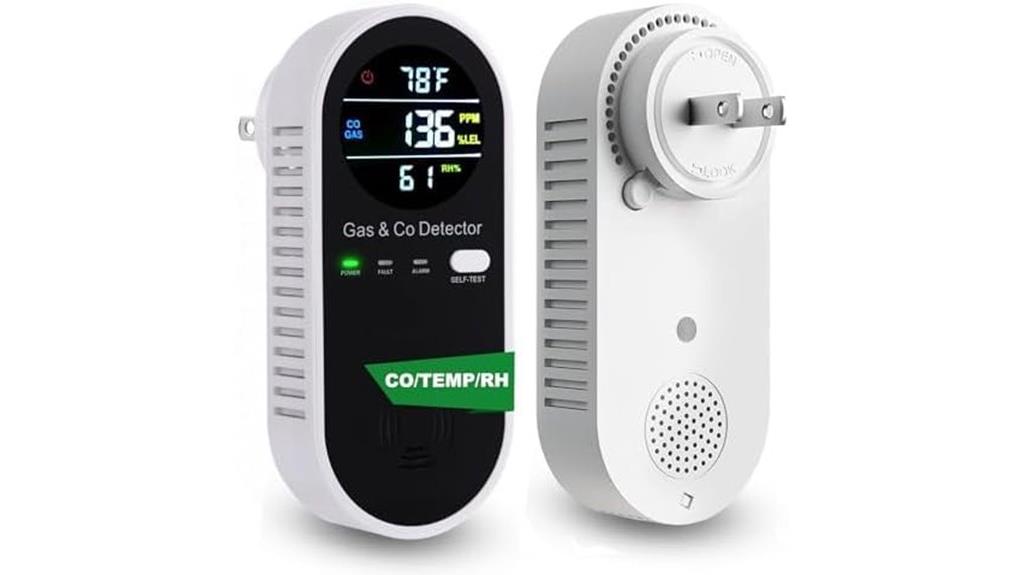
If you need a reliable detector that monitors multiple air quality factors simultaneously, the Combustible Gas & CO Detector 4-in-1 Alarm with Temp/Humidity Sensor is an all-inclusive choice. It detects CO levels from 0-2000 PPM, combustible gases from 0-10% LEL, humidity from 0-99%, and temperature from 1-176°F. Its plug-and-play design makes setup simple, and the high-definition LCD clearly displays real-time data even in the dark. Equipped with precise sensors, it alerts you promptly via loud alarms and flashing lights when dangerous levels are detected. This versatile device is perfect for homes, RVs, and travel, providing thorough safety in one compact unit.
Best For: households, RV owners, and travelers seeking comprehensive real-time air quality monitoring and safety from gas leaks and CO poisoning.
Pros:
- Combines multiple sensors (CO, gas, humidity, temperature) into one easy-to-use device.
- Plug-and-play setup with a clear high-definition LCD display for real-time data.
- Loud alarms and flashing lights promptly alert users to dangerous levels, enhancing safety.
Cons:
- Slightly higher cost compared to single-function detectors.
- May require periodic calibration to maintain sensor accuracy.
- Limited to standard outlets, which could be restrictive in some locations.
2500W Portable Inverter Generator with ECO Mode and CO Alarm
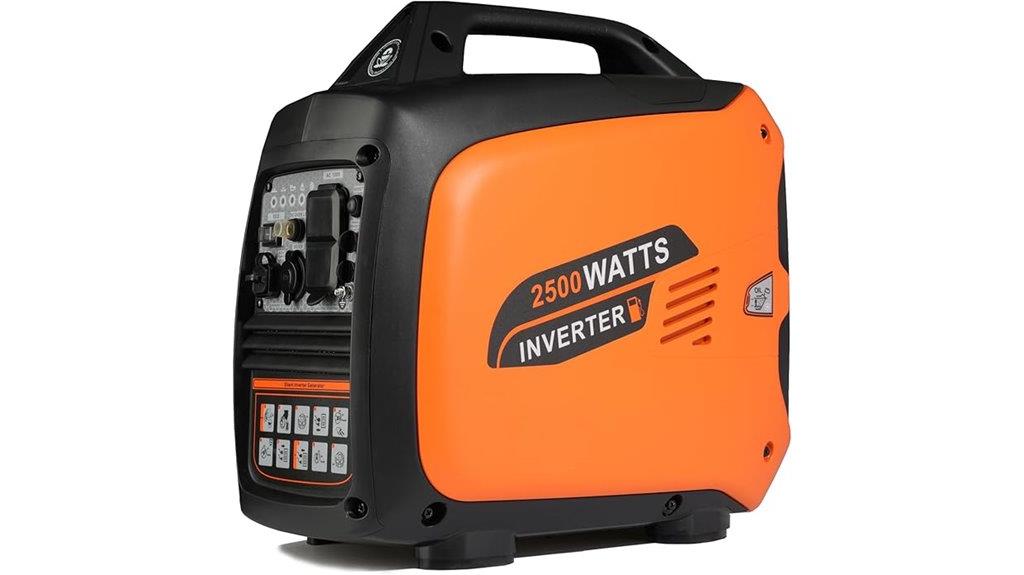
The 0W Portable Inverter Generator with ECO Mode and CO Alarm stands out as an excellent choice for outdoor enthusiasts and homeowners seeking safe, reliable power during camping trips or emergencies. It delivers 2500W peak power and 1800W running power with a pure sine wave inverter, protecting sensitive electronics like laptops and refrigerators. Equipped with multiple outlets, a CO sensor that shuts off the engine if CO levels rise, and ultra-quiet operation at 58 dBA, it prioritizes safety and convenience. Its fuel-efficient ECO mode provides up to 9.5 hours of runtime on a 1.1-gallon tank, all while weighing just 39 pounds for portability.
Best For: outdoor enthusiasts, homeowners, and emergency preparedness individuals seeking a portable, safe, and reliable power source for camping, home backup, or off-grid use.
Pros:
- Delivers stable 2500W peak and 1800W running power with pure sine wave inverter, safe for sensitive electronics
- Features multiple outlets including AC, DC, USB, and Type-C for versatile device charging
- Quiet operation at 58 dBA and built-in CO sensor for enhanced safety and minimal disturbance
Cons:
- Limited fuel capacity of 1.1 gallons may require frequent refueling during extended use
- Weighs 39 lbs, which, while portable, may still be cumbersome for some users to carry over long distances
- Slightly higher price point compared to basic generators without inverter or safety features
5-in-1 Gas, Smoke & CO Detector with HD Screen and Backup Battery
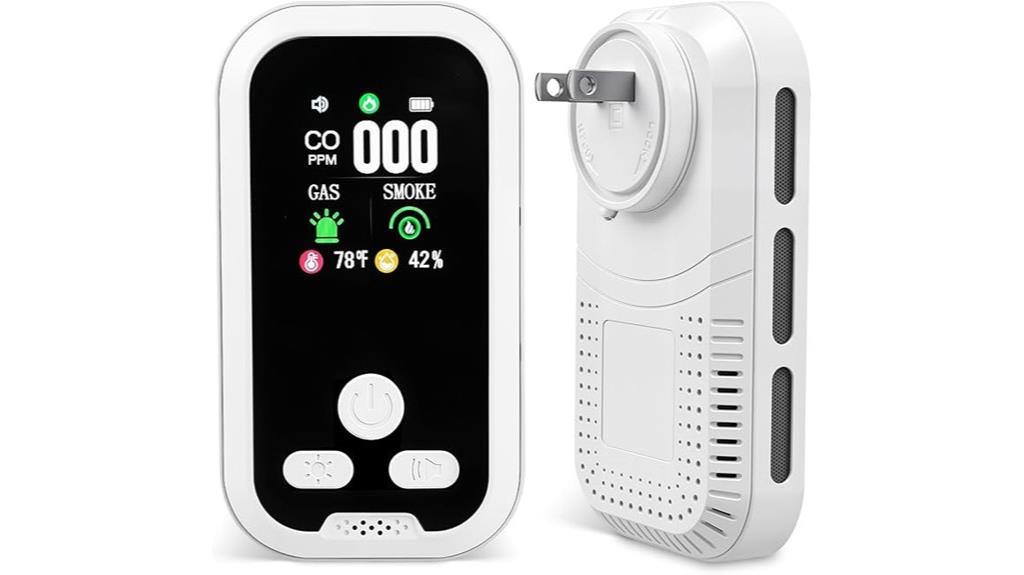
This 5-in-1 detector stands out for its extensive monitoring capabilities, making it an ideal choice for anyone seeking reliable safety during power outages or outdoor activities. It combines smoke, CO, and combustible gas sensors with temperature and humidity displays, providing real-time environment updates. The HD screen offers clear readings even at night, while the loud 100dB alarm and flashing red light deliver quick alerts. Its compact, portable design includes a rechargeable backup battery, ensuring continuous operation during outages. Easy to install and use, it’s perfect for home, travel, or outdoor use, offering peace of mind with multi-threat detection and reliable performance.
Best For: households, travelers, and outdoor enthusiasts seeking comprehensive safety monitoring with reliable alerts during power outages or outdoor activities.
Pros:
- Combines multiple sensors (smoke, CO, gas) with environmental data display for all-in-one safety monitoring.
- Portable, compact design with rechargeable backup battery ensures continuous operation even during outages.
- Clear HD screen and loud alarms provide quick, easy-to-read alerts day or night.
Cons:
- Requires proper installation and calibration to ensure accurate readings.
- Limited to a 4.6-inch size, which may be too small for users preferring larger displays.
- Battery life and recharge cycles may need attention with frequent outdoor or travel use.
Factors to Consider When Choosing a Co Alarm for Generator
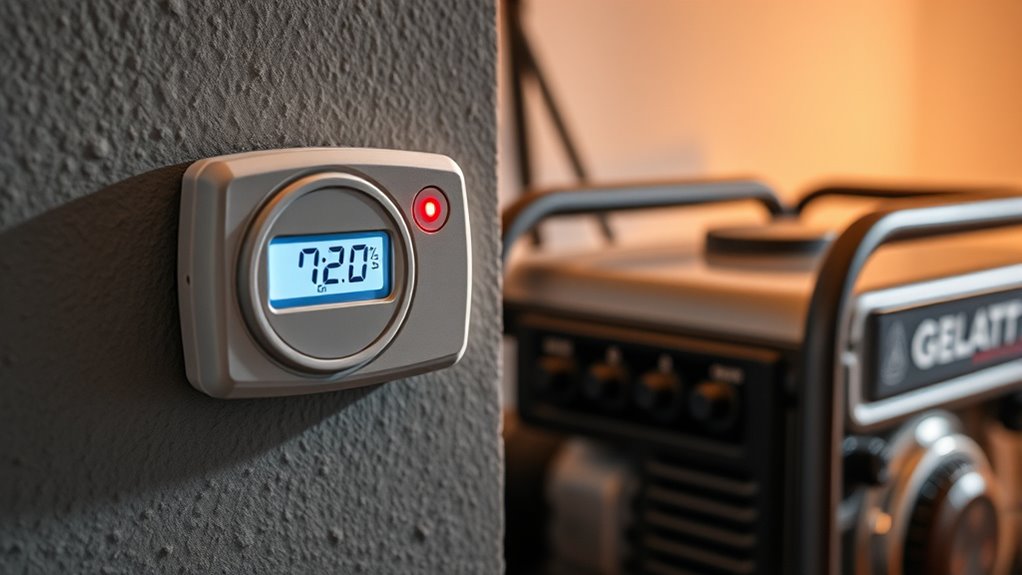
When choosing a CO alarm for your generator, I look at sensor accuracy and the type used to guarantee reliable detection. I also consider the power source compatibility and how loud the alarm is, so I’m alerted promptly. Finally, I check the alarm’s response time and battery life to make sure it stays dependable when I need it most.
Sensor Accuracy and Type
Choosing the right CO alarm for your generator hinges considerably on sensor accuracy and type. Electrochemical sensors are the best choice because they provide precise detection and quick response times, ensuring you’re alerted promptly. Metal oxide semiconductor sensors are less accurate and tend to trigger more false alarms, which can be frustrating. It’s also important to contemplate the sensor’s detection range and sensitivity, typically from 0 to 1,000 ppm or higher, to match your environment. Keep in mind that sensors have a lifespan—most electrochemical types stay reliable for 5 to 10 years before needing replacement. Regular calibration or testing is essential to maintain accuracy, so choose a model that allows easy testing to ensure ongoing safety.
Power Source Compatibility
Selecting the right power source for your CO alarm is vital to guarantee reliable protection when using a generator. You need to match the alarm’s power source with your generator’s output, whether that’s battery-powered, plug-in, or hardwired. Battery-powered alarms are portable and keep functioning during power outages without needing external wiring, making them ideal for backup. Plug-in models with backup batteries can connect directly to generator outlets, offering seamless integration and dependable operation. Some alarms are designed specifically for generator use, featuring automatic shutoff or sensor compatibility with fuel-powered systems. Always verify the voltage and power specifications to confirm your alarm is compatible with your generator’s electrical system. Proper matching guarantees the alarm’s effectiveness and your safety.
Alarm Loudness Levels
Ensuring your CO alarm is loud enough to be heard throughout your space is essential, especially when using a generator. A loudness level of at least 85 decibels is recommended to wake occupants during sleep or in quiet environments. For larger or noisier areas, alarms with 90 decibels or more can offer extra reassurance and visibility. Since carbon monoxide is a silent, odorless gas, the alarm’s loudness is critical for prompt detection and response. Regulatory standards like UL certification often specify minimum loudness levels around 85 decibels for safety compliance. It’s also wise to test the alarm periodically to guarantee it can be heard clearly from various parts of your property, particularly in bedrooms and sleeping zones, for maximum safety.
Maintenance and Battery Life
Regular maintenance of your CO alarm is essential for reliable protection, especially when it’s powering a generator. I recommend checking and replacing batteries every 6 to 12 months to ensure continuous detection. Alarms with long-lasting or rechargeable batteries can reduce the frequency of maintenance and provide extended operation. Keep in mind that most CO sensors last between 5 and 10 years, so replacing the entire unit when it reaches this age is advisable. Look for alarms with low battery warning signals, such as chirping, so you can replace batteries before failure. Following the manufacturer’s instructions for testing and maintenance—like monthly tests and battery checks—helps keep your alarm in top condition. Proper upkeep ensures your safety during power outages.
Response Time Speed
When choosing a CO alarm for your generator, response time speed is a vital factor to contemplate because it determines how quickly the alarm will alert you to dangerous CO levels. Sensors like electrochemical ones respond rapidly, often within 30-60 seconds at high concentrations, providing essential early warnings. Faster response times are essential during sudden leaks or high-level exposures, especially when you’re asleep or in enclosed spaces. The speed of detection varies with CO concentration; higher levels trigger quicker alarms, while lower levels might take longer. Selecting a CO alarm with a proven fast response time ensures you get timely alerts, allowing you to evacuate or take safety measures before CO levels reach life-threatening levels. Speed can truly be a lifesaver in emergency situations.
Certification and Standards
Choosing a CO alarm that meets recognized safety standards is essential for reliable protection, especially when powering a generator. I always look for alarms that are UL listed or certified by a reputable safety organization, ensuring they meet strict safety requirements. Alarms compliant with UL 2034 or UL 1484 standards are specifically designed for residential use and propane detection, providing peace of mind. It’s also important to verify certifications like ETL or CSA approval, especially if I’m in different countries. I pay attention to sensors that use electrochemical technology, as they’re the most accurate and dependable for detecting carbon monoxide. Finally, I confirm the certification covers both detection performance and electrical safety, so I know I’m protected on all fronts during power outages.
Installation Flexibility
Installing a CO alarm for a generator requires flexibility to guarantee it fits your specific setup. I look for alarms with versatile mounting options, like wall-mounting or tabletop placement, so I can choose what works best for my space. A simple, tool-free installation is a must—this saves time and avoids the need for professional help or complex wiring. Adjustable brackets or hardware that adapts to different surfaces make installation even easier. I prefer models that can be powered by batteries, AC outlets, or both, providing flexibility in various environments. Additionally, a lightweight, portable design allows me to move the alarm around or take it during travel. Overall, choosing a flexible installation setup ensures reliable safety without hassle.
Frequently Asked Questions
How Often Should CO Alarms Be Tested for Reliability?
You should test your CO alarm at least once a month to guarantee it’s working properly. I recommend pressing the test button and listening for the alarm to sound. Additionally, replace the batteries every year if it’s not hardwired, and replace the entire unit every 5 to 7 years for maximum safety. Regular testing helps catch any issues early, keeping you and your loved ones safe.
Are CO Alarms Effective During Power Outages Without Backup Batteries?
Think of a CO alarm as your guardian angel—reliable and always watching over you. Without backup batteries, these alarms aren’t effective during power outages; they need a power source to function. If the batteries run out or aren’t present, the alarm becomes silent as a ghost. To stay protected, always guarantee your CO alarms have fresh backup batteries and test them regularly, especially before storms or outages.
What Is the Ideal Placement Height for CO Detectors Near Generators?
I recommend placing CO detectors about 5 feet off the ground near your generator. This height captures the typical breathing zone and allows for quick detection of carbon monoxide. Keep the detector at least 15 feet away from the generator’s exhaust to avoid false alarms. Remember, proper placement guarantees you’re alerted promptly, keeping you and your family safe during power outages or generator use.
Can Multiple CO Alarms Reduce False Alarms During Storms?
Yes, multiple CO alarms can help diminish false alarms during storms. I’ve found that spreading alarms across different areas creates a more reliable system, preventing a single false trigger from sounding the alarm everywhere. It’s like having a safety net—if one alarm detects a problem, others can confirm or dismiss it, reducing unnecessary panic. This layered approach keeps you safer and ensures you’re alerted only when real danger is present.
Do CO Alarms Require Regular Calibration for Accurate Detection?
Yes, CO alarms do require regular calibration to guarantee accurate detection. I recommend testing mine monthly and replacing the batteries at least once a year. Additionally, I follow the manufacturer’s instructions for calibration and sensor replacement, usually every five to seven years. Staying on top of maintenance helps me trust my alarm to alert me promptly if carbon monoxide levels become dangerous, keeping my family safe during outages or everyday use.
Conclusion
In summary, choosing the right CO alarm for your generator is like having a trusty steed in your medieval arsenal—your first line of defense during power outages. Whether you go for battery-powered models or multi-functional alarms, make sure they’re reliable and easy to maintain. Remember, a good CO detector isn’t just a gadget; it’s your modern-day knight protecting you from unseen dangers. Stay safe, and don’t forget to check it regularly—no need for a time machine here!
